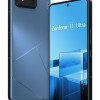Review: Garmin Asus Garminfone
Garmin Asus has done more to alter the look and feel of the Android interface than any other manufacturer so far, even more than HTC with its Sense interface. While HTC Sense builds on top of the existing Android design, the Garminfone replaces the paradigm almost entirely. Instead of the stock UI, Garmin has installed its Breeze interface, which is nearly identical to its navigation devices. The interface looks great. It's better than the stock Android UI, though it doesn't lack any of Android's signature features. The notification bar still drops down from the top. The menu still jumps up from the bottom. You can still hold your finger down on an icon to rearrange the screen, or access enhanced functions. But where I occasionally found Android counterintuitive because of all these options, the Garminfone relies less on the pop-up menus and long press features, and keeps things a bit more simple on screen. You can usually find the feature you want without much digging.
The main menu screen is divided into thirds. About two-thirds of the screen is taken up by only three large buttons: Call, Where To?, and View Map. While the large icons make tapping easy, especially from the driver's seat (a warning not to operate while driving pops up every time you start the phone), the phone icon seems unnecessary, and it's rare that I simply want to view my place on the map without jumping into a search or nav session. It would be cool to have an option to swap these three with a large icon version of any app, so I could have my top three favorites, and then all the rest.
Next to the big three is a sliding column of icons. You can slide this panel left to reveal the application drawer. Though the drawer is hidden from the main screen until you drag it out, you can swap the icons in the visible sliding column with any in the drawer, adding as many as you like. It's a nice looking, elegant way of handling the Android application drawer.
While most Android phones offer widgets and a customizable set of home screens, the main screen on the Garminfone is mostly static, except for that sliding column, but that doesn't mean it doesn't support widgets. There's a separate widget icon, and when you tap it the screen background goes dark and you get five full screens on which you can place a number of widgets. Garmin Asus doesn't offer nearly the collection that HTC offers with its Sense UI phones, but all the basics are there, including a calendar, Facebook, music controls and the Power Control settings strip to manage power saving settings like Wi-Fi, screen brightness and backrgound sync. There's also a recent applications widget from Garmin. The widget pages aren't as fun and friendly as a vanilla Android phone, with photo galleries and loads of shortcuts, and it sticks to a barebones assortment of useful widgets instead. Even so, you can install new widgets from the Android market, and when an app comes with a widget, like Facebook, it's available on the Garminfone.
Overall, Garmin Asus has done a nice job polishing the entirety of the Android UI, leaving no stone unturned. The main home screen changes color as day turns to night. The settings menus are all Garmin designs. The Web browser uses a Garmin interface. Even the Power Control strip has been retouched to match the Garmin theme. There's a thoughtful level of consistency in this phone, and even though it lacks some of the features that are part of the stock Android interface, it's stylish and completely functional.











 T-Mobile Will Carry Android Powered Garminfone
T-Mobile Will Carry Android Powered Garminfone
 iPhone 14 Plus Offers a Big Screen For Less
iPhone 14 Plus Offers a Big Screen For Less
 Qualcomm Taps Iridium for Satellite Connectivity
Qualcomm Taps Iridium for Satellite Connectivity
 Asus Goes Big with Zenfone 11 Ultra
Asus Goes Big with Zenfone 11 Ultra
 iOS 16 Revamps the Lock Screen
iOS 16 Revamps the Lock Screen
 Garmin Asus Garminfone
Garmin Asus Garminfone


